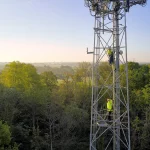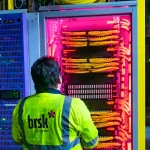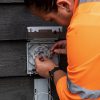Broadband Altnet Spring Fibre UK Sold to Harmony Networks for Just £1.5m

Alternative broadband operator Spring Fibre, which began attempting to deploy a new 10Gbps capable wholesale full fibre (FTTP) network for ISPs to use in 2021 – starting in Lincolnshire (here), has been sold by their administrators to Leeds-based Harmony Networks for £1.5m after only having passed 12,000 UK premises (RFS).
The operator, which was initially backed by Kingsley Capital Partners and telecoms specialist Graphite Strategy, is known to have originally secured an investment (loan) of “up to” £155m from R&M’s (River and Mercantile) infrastructure business to support their original aspiration of covering 1 million premises in England (here).
However, in the years since 2021, we’ve seen very few updates on their build progress and no sign of any retail ISP availability. The operator did appear to start building in Lincoln, as well as the small towns of Mablethorpe and Louth during early 2023 (here), while some of our readers also claimed to have spotted their contractors, SCD, working in or around locations like Garforth/Kippax, as well as the village of Great Preston.
Advertisement
The problems at Spring Fibre started to become more evident in September 2024 with the publication of their annual accounts (here), which revealed that their principal investor would “not continue to fund its network construction plan“ or meet their continued operational expenditure (finding a new investor in today’s environment of high interest rates and competitive network build is a challenging prospect).
Nevertheless, a spokesperson for the altnet told ISPreview, perhaps rather over optimistically, that Spring Fibre was still “in a strong position as they continue to build network in the East and Northeast of England, with supportive investors, having gone live with Customers in recent months.” But shortly after that they moved to appoint an administrator (here) and Fti Consulting later secured the role.
Outcome of Administration
Fti Consulting have now published their statement of proposals, which lifts the lid on the reality of Spring Fibre’s situation and confirms that, following their appointment, the joint administrators “completed a sale of substantially all of the Company’s assets to Harmony Networks Limited for £1.5m“. This asset purchase comprises intellectual property rights; plant and machinery; work in progress (“WIP”); business information; IT; stock; office equipment; and certain contracts.
The document, which has been seen by ISPreview, reveals that “despite ongoing investment and successfully growing its network to 12,000 ready-for-service premises, the Company has not reached the stage where it was generating revenue, cash or profits and so has been dependent on the support of its shareholders and the Secured Creditor to fund the Company.”
Advertisement
The administrator’s report notes that, by July 2023, the Company had already utilised c.£15m of its Loan Agreement and, despite later attempts to reduce the “cash burn”, the Company continued to require funding in the region of c.£1.5m per month.
Extract from Administrator’s Report
However, the Company faced challenges from rising build costs in a highly competitive market, resulting in the abandonment of certain build projects, with overbuild threats materialising at a faster pace than anticipated, procurement challenges as well as the ongoing operating cost outflow given the pre-revenue nature of the asset.
In September 2023, the investors brought in a new CEO to re-invigorate the business, establish a new management team and undertake an operational restructuring of the Company. The new management team identified £5.1m of impairments to the build projects undertaken to date.
In May 2024, Fiera Infrastructure took over from RMI (the fund manager responsible for overseeing the investment into the Company). Representatives from Fiera subsequently replaced the directors appointed by the former fund manager.
The Company continued to incur losses (c.9.0m EBITDA loss in FY23 and a £2.8m EBITDA loss in the year to June 2024) and to draw down further on the Term Loan to fund the ongoing fibre roll-out.
The Company was also unable to meet its cash pay interest due to the Secured Creditor on 30 June 2024 or 30 September 2024 amounting to c.£664k and c.£619k respectively. The Secured Creditor is said to have reserved their rights in respect of the non-payment which constituted an Event of Default.
As we already known, Spring Fibre ultimately failed to find a new source of investment, although it is revealed that they initially received a non-binding offer from one unnamed operator to buy the business before it fell into administration. But following more engagements, the offer was withdrawn and it was later deemed that “no solvent solution could be found“, which is when the administrator was appointed.
“During the week commencing 21 October 2024, the Company recommenced an accelerated sale process and contacted 16 parties (14 of which had been contacted during the initial M&A process). The parties were informed that the Directors had filed an NOI, and that the business and/or its assets were still available for sale. A bid deadline of 28 October 2024 was set, and three offers were received, including an offer for the Company’s assets from Harmony Networks Limited (the “Purchaser”),” added Fti’s report.
Advertisement
The offer received from Harmony Networks is said to have “represented the best return to the creditors as a whole” (i.e. as opposed to letting it all fail), although at £1.5m (c. £125 per premises) it’s obviously a price that falls well below the amount of money that has already been blown (creditors won’t be getting much of their money back). Just for context, the Secured Creditor’s lending to the Company as at the date of Administration was c. £33.5m.
We don’t know much about Harmony Networks itself, but the SCD Group (Spring’s contractor) is stated to be an entity under the same person of significant control as the Purchaser. Quite what SCD plans to do with the network they’ve just purchased is unclear, but we do note that their engineers have helped to build some other fibre networks too, such as for Connexin.
Mark is a professional technology writer, IT consultant and computer engineer from Dorset (England), he also founded ISPreview in 1999 and enjoys analysing the latest telecoms and broadband developments. Find me on X (Twitter), Mastodon, Facebook, BlueSky, Threads.net and Linkedin.
« Ofcom UK Warns One Touch Switching Laggard ISPs to Get Onboard UPDATE






















































“However, the Company faced challenges from rising build costs in a highly competitive market, resulting in the abandonment of certain build projects, with overbuild threats materialising at a faster pace than anticipated, procurement challenges as well as the ongoing operating cost outflow given the pre-revenue nature of the asset.”
Whilst 30 minutes away my town is still without full fibre so surely would make sense to build somewhere with no competition.
If it costs too much to build there then no. Any combination of it being difficult to get network connected there, homes being spread out, street layout making construction expensive, Openreach network being unavailable or needing repair can mean it makes more sense to build elsewhere even if there’s competition.
They have to assume Openreach will overbuild them in their calculations too.
25% market share at £300 per premises or 50% at £1k. Half the income for less than a third the build cost and lower rental costs on Openreach ducts and backhaul. Getting there 6 months before Openreach and then getting overbuilt not much use: most contracts are 18-24 months now and takes altnets a year to get 10-15% share when when FTTC is the only competition.
The pole serving my home went live with GoFibre at the beginning of August. I was getting 75/20 service on FTTC from Openreach. It serves 11 properties. My mid September three properties had taken GoFibre (one being me) for a 27% takeup rate. I have no idea what the takeup rate is elsewhere in the area but I will be honest I was very surprised at the takeup rate given there is a very good FTTC option.
12,000 properties RFS probably equates to less than 1,000 paying customers, maybe bringing in £20K per month revenue? From that they have all the costs of running a boutique ISP. And without a known brand, they could only compete on price. They never had a chance.
If their business case depended on “no overbuild” then it was never going to succeed anyway.
If you read the article it never had any customers and didn’t generate any cash.
They were a wholesale provider, so service wouldn’t have been sold under the Spring name to end users.
While Harmony bought most of the stuff, they declined to take on any of the staff who actually knew how everything hangs together, as the entire workforce was made redundant.
Contrary to another reply, they did have a live wholesale customer and were online.
@Ex staffer – So the administrators were lying then about no customers??
It’s coming thick and fast, just when an alt nets thinks it’s safe it’s gets hit with millions in civils defects and fibre overlays, build once build correctly.
Ouch, some investors got their fingers burnt and many more will do too in the near future.
So glad I’m out of the fibre fantasy industry.
Trying to build a small wholesale network was never wise in my view, ISP’s don’t want to deal with dozens of small wholesale networks it i just to much hassle
So it was funded 100% via debt, and it had a pitiful amount of funding to get going, its demise isnt really a surprise.